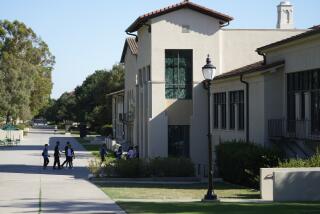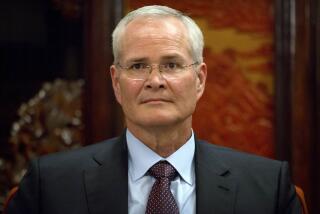Lockheed’s Chief Predicts Victory in Wake of Vote : Defense: Tellep says his slate of directors beat rivals, but he offers big concessions to supporters of the Harold Simmons camp.
- Share via
Lockheed Chairman Daniel M. Tellep predicted victory for his incumbent directors Thursday after voting ended in a hotly contested board election, but he also offered major concessions to shareholders who supported the dissident slate of nominees led by Texas investor Harold C. Simmons.
“We feel very positive about the vote,” Tellep told reporters at a news conference after Lockheed’s annual meeting. However, he acknowledged that his conclusion was based on “just my impressions from what I’ve heard so far.”
Shareholders had their final opportunity at the meeting to choose between the rival slates. The official results will be announced at a special shareholder meeting April 16 in Woodland Hills.
Much of the support for the current board came from Lockheed’s employee stock ownership plan. More than 90% of the plan’s stock was voted in favor of the incumbents, Lockheed said late Thursday.
However, those votes may be contested because the Simmons camp claims that a major block of the shares allotted to members of the ESOP were improperly voted by the ESOP trustee. With 18.91%, the ESOP controls the second-largest chunk of Lockheed stock. Simmons-controlled NL Industries, a Houston chemical company, is the largest shareholder, with 18.94%.
Even though voting was completed Thursday, the outcome will not be known for more than two weeks because of late votes and vote switches, which are allowed in corporate proxy elections.
Both sides courted individual shareholders but devoted most of their time to wooing institutional shareholders and members of the ESOP.
Observers and advocates associated with both board slates had recently been predicting a close election. NL Industries President J. Landis Martin held to that line after Thursday’s meeting.
“It’s going to be a close vote, and I can’t predict an outcome,” he said. Martin and Simmons held a news conference following the meeting. However, in another statement, reported by Associated Press, Martin seemed less than optimistic.
“It’s like a political campaign,” he said. “Sometimes you just have to come back again the next time.”
Simmons--appearing to be in a somewhat somber mood--expressed regret that there hadn’t been enough time to conduct an effective fight. “If we had more than five weeks to campaign, we could have won more votes,” he said.
However, Tellep sounded confident during a separate news conference, saying: “We expect a clear majority in every category except the Simmons shares.” Asked why he thought his slate won, Tellep--sometimes testy during the meeting with reporters--said “because reason prevailed.”
Simmons’ camp had rallied a number of institutional shareholders under the banner of shareholder rights, a movement that asserts that management should be more directly responsible to stockholders. Rights advocates typically oppose anti-takeover provisions and favor confidentiality in voting.
During the meeting, which was held in a huge hangar at Lockheed’s Burbank complex, Tellep offered several concessions to shareholders, including secret votes if that is what a significant number of shareholders want.
He also promised:
That he will ask investor groups for a list of shareholder representatives who could be named to Lockheed’s 15-member board and that he will select up to three directors from that list. He had offered earlier to appoint only one such director.
A provision to opt out of strict anti-takeover provisions of law in Delaware, where Lockheed is incorporated. Such a proposal was among the proxy issues on which shareholders voted Thursday. Tellep said that even if the provision does not pass, he will recommend that the board support an amendment at the next meeting to have Lockheed opt out if there is a “significant” minority vote for it.
To meet regularly with Simmons’ representatives to discuss Lockheed’s future.
Responding to Tellep’s offer to meet frequently, Simmons told shareholders he would rather have three of his own seats on the board. “Then we (Tellep and Simmons) could be friends,” Simmons said, drawing some laughter.
Simmons in January had asked Tellep for six board seats, a request that Tellep quickly rejected. After that, Simmons mounted his proxy fight.
Simmons has criticized Lockheed management for a decline in earnings in 1989, when Lockheed had a profit about $2 million on sales of $9.9 billion, compared to a profit of $624 million on sales of $10.4 billion the previous year. Lockheed has attributed much of that decline to about $500 million in losses associated with five fixed-cost defense contracts, projects on which it was prohibited from recovering excess costs.
The company’s new non-defense-related ventures have also been a bone of contention. Calling it “failed diversification,” Simmons promised to concentrate on Lockheed’s core business of aerospace and defense-related contracting.
Tellep eschewed the term “diversification” in favor of a phrase--”new initiatives based on current capabilities.” Tellep has maintained that Lockheed must reduce its reliance on military business because of reductions in Pentagon spending.
Martin, the NL Industries president, reiterated his belief that Simmons could better focus Lockheed on its core businesses--aeronautics, space and missiles. “We believe Lockheed must return to its roots,” Martin said.
Meanwhile, Simmons and Martin said they were considering whether to challenge the way the ESOP shares were voted.
A spokesman for U.S. Trust Co. of California, the trustee for Lockheed’s employee stock ownership plan, said the trustee did not receive instructions on how to vote a block of shares believed to number at least 500,000 of the roughly 12 million shares owned by the plan. Despite the lack of instructions, the trustee voted the shares for management, according to Charles Wert, U.S. Trust’s senior trust officer.
The Simmons group said those shares should not have been voted for either side if no instructions were received. Notices sent to shareholders warned that votes would not be cast unless voting instructions were received by the trustee by March 27.
But Wert said the trustee determined that it must vote all the ESOP shares--even those for which it had received no instructions--to satisfy its fiduciary duty as trustee.
“There’s no controversy as far as I’m concerned,” Wert said. “Those shares were voted because we thought it was prudent to do so.”
Times staff writer Nancy Rivera Brooks contributed to this story.
SIMMONS’ MOVE ON LOCKHEED
1989
April 3: Harold C. Simmons, through his Houston-based chemicals company NL Industries, says that he has acquired 5.3% of Lockheed stock and that he may seek control of the company.
April 4: In an effort to preempt a takeover by Simmons, Lockheed announces a major restructuring that includes sale of its information systems units and establishment of an employee stock ownership plan.
April 5: Simmons discloses that he has sold 200,000 Lockheed shares, lowering his stake to 4.2%.
Sept. 29: Simmons, after several months of increasing and decreasing the size of his Lockheed holdings, discloses that he owns 10.43% of the company.
Oct. 2: Lockheed discloses that it will take a $165-million writeoff against several major defense programs involving fixed-price contracts, further depressing already weak earnings for the year.
1990
Jan. 17: NL Industries boosts its stake in Lockheed to 17.9%.
Jan. 31: Lockheed Chairman Daniel M. Tellep rejects Simmons’ demand for six seats on the company’s board and his request that Lockheed drop the anti-takeover measures erected after Simmons began buying shares last year.
Feb. 2: In a Securities and Exchange Commission filing, Simmons discloses that his investor group has increased its stake in Lockheed to 18.94% of the common stock and may seek control of the board of directors.
Feb. 4: Simmons announces that the SEC is investigating trading by NL Industries in Lockheed and Georgia Gulf Corp. stock.
Feb. 16: Lockheed announces that it will move up its annual meeting, usually held in May, to March 29 and that it has hired proxy-fight consultants.
Feb. 22: Simmons announces his rival slate of 15 nominees to replace Lockheed’s board and indicates that he and NL Industries will spend almost $6 million on the proxy solicitation campaign.
March 12: A proxy challenge is officially launched by Simmons.
March 14: Simmons says he will put an employee representative on the Lockheed board if his proxy fight is successful.
March 27: Two state pension fund managers--the California Public Employees’ Retirement System and the Florida State Board of Administration, together controlling about 1.1% of Lockheed’s stock--disclose their support for Simmons’ slate of directors.
March 28: The Lockheed board receives backing from a group of New York City pension funds owning 0.5% of the company’s stock, while the Simmons slate is endorsed by the California Teachers Retirement Fund, controlling 0.6%.
March 29: Proxy fight ends at Lockheed’s annual meeting, with both sides making final bids for shareholders’ votes.
More to Read
Inside the business of entertainment
The Wide Shot brings you news, analysis and insights on everything from streaming wars to production — and what it all means for the future.
You may occasionally receive promotional content from the Los Angeles Times.










